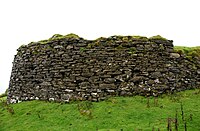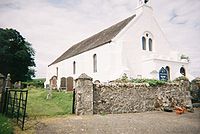Lismore
| Lismore Gaelic: Lios Mòr | |
 Achadun Bay, Lismore | |
|---|---|
| Main village: | Achnacroish |
| Location | |
| Location: | 56°31’12"N, 5°30’0"W |
| Grid reference: | NM840408 |
| Area: | 5,809 acres |
| Highest point: | Barr Mòr, 417 feet |
| Data | |
| Population: | 146 |
Lismore is a an island of the Inner Hebrides within Argyllshire. It is fertile, low-lying island not open to the ocean but within Loch Linnhe, east of Mull.
The island is partially Gaelic-speaking. Its name is Gaelic and means "great garden" or "great enclosure"; lios mòr. The name may reflecting either the fertility of a relatively low-lying island amidst mountainous surroundings, or the presence of a defined sacred area round the early monastery.
Lismore was once a major centre of early Christianity, with a monastery founded by Saint Moluag and the seat of the Bishop of Argyll.
Contents
Geography
The island is linked to the mainland by two ferries: a vehicle ferry making the crossing to Oban and a foot ferry making a shorter crossing from the northern tip of the island to Port Appin.
Lismore Lighthouse, built by Robert Stevenson, lies on the small island of Eilean Musdile to the south west with Lady's Rock about half a mile further away in the same direction.
Lismore lies at the heart of the Lynn of Lorn National Scenic Area.
Landscape and geology
Lismore is composed almost entirely of Dalradian limestone,[1] it has fertile soil and an abundance of trees and shrubs.[2]
Lismore, like other Hebridean islands, has suffered from depopulation since the 19th century. In 1845 there were 1430 people living on the island, though by 1971 there were only 180.[3] In the 2001 census, the population was 146, over 45% of whom were over 60 years old, making it the Scottish island with the oldest population.[4]
Farming has always been important, with barley and oats grown in the 18th and 19th centuries. Today cattle and sheep raised here are in great demand throughout Scotland.[1]
Lime was quarried, particularly on the west coast.[2]
Prehistoric sites
Tirefour Castle is an Iron Age broch of uncertain date. The walls have an average thickness of 14.8 feet enclosing a court about 40.0 feet in diameter. The wall still stands 9.8 feet (3.0 m) high.[5][1]
History
Saint Moluag
Saint Moluag (Old Irish Mo-Luóc) (d. 592) founded a monastery on Lismore. The island was a major centre of Christianity, and the seat of the later mediæval bishopric of Argyll or the Isles. To modern eyes it seems an isolated location for such a centre, but in an era when the fastest and most reliable transport was by water, Lismore was ideally situated. Of the cathedral only the choir survives, in greatly altered form, the nave and western tower having been reduced to their foundations. Since the Reformation the choir has been used as the Parish Church of Lismore.
Other attractions
Other major antiquities on Lismore include an impressive broch and two ruined 13th century castles, Coeffin Castle and Achanduin Castle, the latter was the seat of the Bishopric of Argyll until the early 16th century.
Livingstones of Bachuil
Lismore is the home of the highland Clan MacLea, whose chief, is now Niall Livingstone of Bachuil, Baron of the Bachuil, who succeeded his father Alastair Livingstone of Bachuil, who died on 29 February 2008. Livingstone is the Coarb of Saint Moluag and, as such, the hereditary keeper of the saint's crozier or pastoral staff (an early church relic known as the Bachall Mòr).
The Piper's Cave
The Pipers cave was a cave which in a local story a piper and his dog went in and all that returned was the pipers shaven dog.[6]
Pictures
References
- ↑ 1.0 1.1 1.2 "Isle of Lismore: History". Isle of Lismore Community Website. http://www.isleoflismore.com/History/history/history.htm. Retrieved 2008-11-01.
- ↑ 2.0 2.1 "Overview of Lismore". Gazetteer for Scotland. http://www.scottish-places.info/features/featurefirst1552.html. Retrieved 2008-11-01.
- ↑ "Isle of Lismore". Tom Paterson Genealogy. http://web.ukonline.co.uk/members/tom.paterson/lismore.htm. Retrieved 2007-08-17.
- ↑ "Scotland's Island Populations". Scottish Islands Federation. http://www.scottish-islands-federation.co.uk/population.htm. Retrieved 2008-11-01.
- ↑ "Lismore, Tirefour Castle". Canmore. Retrieved 12 August 2012.
- ↑ "The Celtic Review" ambaile.org.uk.
Outside links
| ("Wikimedia Commons" has material about Lismore) |







